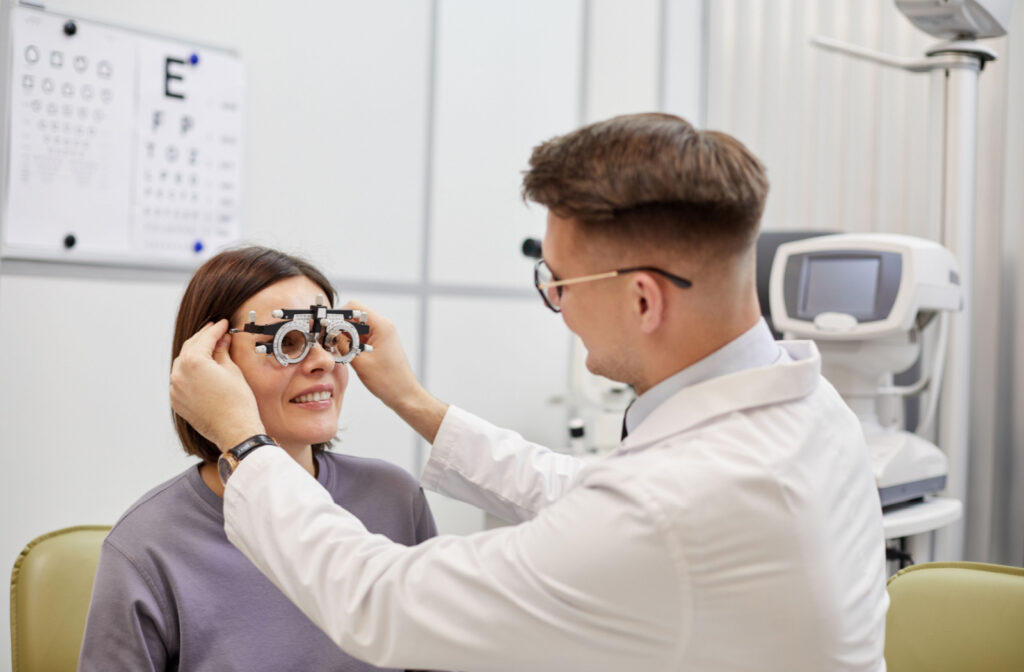Astigmatism is a common refractive error that distorts your vision. If you have astigmatism, you might have been told that you need glasses or contact lenses to correct your vision. But glasses can’t “fix” your astigmatism.
During a comprehensive eye exam, your optometrist will determine the degree of your astigmatism. Typically, there’s no need to jump to more invasive solutions right away.
What Are Refractive Errors?
Every part of your eye works together to help you see. The cornea, the clear front surface of your eye, acts like a protective shield and helps focus light. The lens, located right behind the iris, focuses the light onto the retina, the light-sensitive layer of cells at the back of your eye. The retina captures the light and sends it as signals to your brain, which turns them into the images you see.
Refractive errors occur when a part of your eye isn’t shaped correctly so the light entering your eyes isn’t focused on the retina, which means you can’t see clearly. Refractive errors are the most common type of vision problem, affecting nearly 150 million Americans.
There are several types of refractive errors. Your eye doctor can prescribe eyeglasses or contact lenses to help correct your vision.
Myopia
Nearly 30% of the population is nearsighted. Also known as myopia, nearsightedness means you can clearly see objects up close but have difficulty seeing things that are far away. Myopia occurs when your eye is too elongated or the curvature of your cornea is too steep, causing light to land in front of the retina instead of directly on it.
Hyperopia
Farsightedness is the opposite of myopia. Also known as hyperopia, farsightedness makes distant objects appear clear but close-up objects blurry, making tasks like reading a book or using a computer difficult without glasses. Hyperopia occurs when the shape of the eye is shorter than normal, causing the light to focus behind the retina instead of directly on it.
Astigmatism
Astigmatism occurs when the cornea or lens of the eye is irregularly shaped, causing light to focus on more than one point in the eye. This results in blurred and distorted vision and often leads to eye discomfort and headaches.
Astigmatism can develop alongside myopia or hyperopia and can be corrected using prescription eyeglasses, contacts, or LASIK eye surgery. If you have astigmatism, you may need specialized contact lenses custom fit to your eyes.

What Is Astigmatism?
Normally, the cornea and lens are symmetrically curved, allowing light to enter the eye and focus on the retina. However, astigmatism occurs when the cornea and lens are curved asymmetrically, causing light to be scattered, creating distorted or blurred images, and resulting in difficulty seeing objects at certain distances or in certain conditions.
Symptoms of Astigmatism
The symptoms of astigmatism can vary depending on the severity of the condition. Some common signs and symptoms include:
- Blurred vision
- Distorted images
- Eye strain
- Headaches
- Difficulty seeing at night
If you experience any of these symptoms, visit your optometrist for a comprehensive eye exam.
Causes of Astigmatism
The exact cause of astigmatism is not known, but it’s believed to be genetic and can be present at birth or develop over time. Certain medical conditions such as keratoconus or eye injuries may also contribute to astigmatism.
How to Treat Astigmatism
Corrective Lenses
Glasses or contact lenses are commonly used to correct astigmatism. These corrective lenses have a unique design that compensates for the irregular shape of the eye, allowing light to focus correctly on the retina. Glasses for astigmatism have a cylindrical lens that corrects the uneven curvature of the cornea or lens.
Glasses alone may not entirely correct astigmatism. Some may benefit from a combination of glasses and contact lenses. Contacts sit directly on the eye’s surface and provide a more precise correction than glasses. Some people find contacts to be more comfortable and convenient than glasses, especially for sports and other physical activities.
LASIK
LASIK is a surgical procedure that reshapes the cornea to correct vision problems like nearsightedness, farsightedness, and astigmatism. However, not everyone is a good candidate for LASIK, and there are risks and complications associated with the surgery.
As you age, your vision commonly changes, and you’ll need to update your prescription or switch to a different type of corrective lens. Regular eye exams are essential for monitoring your vision and detecting changes or issues that may need to be addressed.
Correct Your Astigmatism with the Right Lenses
Glasses or contact are a time-honored correction for astigmatism and other refractive errors. As your eyes change, your prescription lenses may need to be updated, especially if astigmatism develops alongside myopia or hyperopia.
Regular eye exams are key to keeping your vision clear and your eyes healthy. Schedule a comprehensive eye exam with the team at Family EyeCare Center to monitor changes in your vision and detect eye conditions before they develop.



